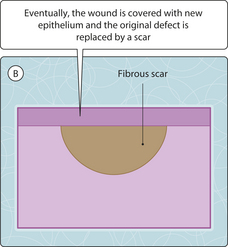Chapter 14 Healing of wounds and fractures
Wound healing
Healing of wounds involves inflammation, granulation tissue formation and fibrosis. The process is controlled by a complex network of cell–cell and cell–matrix interactions. Inflammatory cells are required to fight infection, especially in contaminated wounds. Phagocytes remove necrotic tissue and blood clot and also attempt to digest particles of foreign material contaminating the wound (the last is characterized histologically by foreign body giant cells). Granulation tissue revascularizes the damaged tissue, and the deposition of collagen and other matrix materials leads to the formation of a scar (Ch. 7).
If there has been a breach in an epithelial surface, epithelial cells from the edge of the wound grow over the granulation tissue, reepithelializing the damaged area (Fig. 3.14.1). This process is also controlled by a complex series of cell–cell and cell–matrix interactions.
Factors inhibiting wound healing
There are a number of factors that can inhibit wound healing.
Stay updated, free articles. Join our Telegram channel

Full access? Get Clinical Tree










